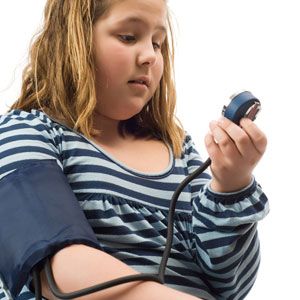Hypertension in children—a troubling and increasingly common problem for the under-20 crowd—is related to low vitamin D status, a finding that suggests the condition may be reversible with a simple nutritional intervention.
 Claudia Banzato and colleagues at the University of Verona, Italy, report that nocturnal blood pressure in overweight and obese children appears to be inversely correlated with vitamin D status, echoing a correlation initially seen in adults, according to a new study by researchers at the University of Verona.
Claudia Banzato and colleagues at the University of Verona, Italy, report that nocturnal blood pressure in overweight and obese children appears to be inversely correlated with vitamin D status, echoing a correlation initially seen in adults, according to a new study by researchers at the University of Verona.
The researchers measured anthropomorphic parameters, vitamin D levels, and ambulatory 24-hour blood pressure in a cohort of 32 obese kids, aged 7-16 years. They found a clear relationship, though they hesitated to imply causality.
Compared with the children in the highest vitamin D tertile, those in the lower tertiles had greater insulin resistance and higher 24-hour and nighttime systolic and diastolic ambulatory blood pressure across all BP measurements recorded by the research team, reported Dr. Banzato in the Journal of Human Hypertension.
“The percentage of subjects with pathological 24-hour systolic BP load, nighttime SBP load, nighttime diastolic BP load, nighttime SBP index and nighttime DBP index increased progressively as the vitamin deficiency categories increased.”
While vitamin D correlated inversely with 24-hour and nighttime systolic pressure, nighttime systolic and diastolic load, and 24-hour and nocturnal systolic indices, the nocturnal effect seemed to be more prominent.
“Low levels of vitamin D in obese children were associated with a higher BP burden, especially at night.”
It is not known whether supplementation with vitamin D can reduce blood pressure in obese kids, and the current study was not designed to evaluate that possibility. But it is certainly plausible, and there is little harm in trying it.
The connection between low vitamin D and hypertension was shown clearly in a 2011 study of 833 Scandinavian adults. A multicenter Swedish team found that men with 25-(OH)-D concentrations under 37.5 nmol/L (under 15 ng/mL) had a 3-fold higher prevalence of confirmed hypertensioncompared to those with levels exceeding 37.5 nmol/L(-1) 25(OH)D (Burgaz A, et al. J Intern Med. 2011; 269(2): 211-18)
The Verona study is the first to show a clear relationship between vitamin D deficiency and hypertension in kids, but the relationship between low vitamin D and childhood obesity is well established.
In 2006, Margarita Smotkin-Tangorra and colleagues at Maimonides Medical Center, New York, NY found that 55% of a cohort of 217 obese children and teens had blood levels of vitamin D less than 20 ng/mL), and 22% were severely deficient with levels under 10 ng/mL. The investigators did observe a pattern of higher systolic and diastolic pressures in the vitamin D-deficient kids (Smotkin-Tangorra M, et al. J Pediatr Endocrinol Metab. 2007; 20(7): 817-23).
END







